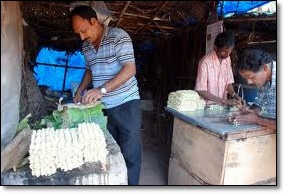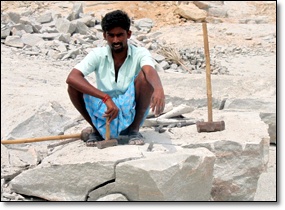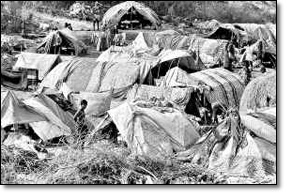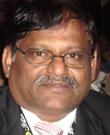Immigrant labourers Vs local residents : Shantipura pays for Progress
By Philip Mudartha
Bellevision Media Network
Udupi, 11 Apr 2013: Let me tell you this true story of my native village in coastal Karnataka. Population is approximately 4,000 living on farmlands of about eight square miles. Roughly 40% are Catholics, who are good agriculturists and floriculturists. They train their men-folk into mechanics, stewards, priests and drivers and export them wherever they are needed. They also export their women-folk all over the world as nuns, nannies, nurses and secretaries. Those, admittedly, “not of export quality” remain behind and tend to run the village affairs.
 I have annually updated my “census” of the village. It has a Catholic Church and a Protestant Prayer Hall to serve the Christians. The Hindus have four Temples (devastanas), half a dozen shrines (mandirs), and a dozen oracles (banns). All of them lived peacefully in harmony, so we changed its name from Pamboor to Shantipur.
I have annually updated my “census” of the village. It has a Catholic Church and a Protestant Prayer Hall to serve the Christians. The Hindus have four Temples (devastanas), half a dozen shrines (mandirs), and a dozen oracles (banns). All of them lived peacefully in harmony, so we changed its name from Pamboor to Shantipur.
All was well till someone had a brilliant idea and he started to drill holes in appropriate places and discovered high quality construction materials, granite included, under the earth. These not so brilliant started to mine the abundant black rocks for stones.
 As none of the natives had skills in drilling and use of explosives, hordes of “immigrant skills” were brought in “sponsored” by those who managed to weasel out quarry permits from Geological Authorities. These poorly paid, and sometimes unpaid, miners lived in squalid huts by the roadside on public land and “polluted” the village. Or so the natives thought when the bare breasted immigrant men, women and children urinated, defecated, and bathed in the open. Wealth came from the front door; noise, dust and disease from the rear. Peace was shattered.
As none of the natives had skills in drilling and use of explosives, hordes of “immigrant skills” were brought in “sponsored” by those who managed to weasel out quarry permits from Geological Authorities. These poorly paid, and sometimes unpaid, miners lived in squalid huts by the roadside on public land and “polluted” the village. Or so the natives thought when the bare breasted immigrant men, women and children urinated, defecated, and bathed in the open. Wealth came from the front door; noise, dust and disease from the rear. Peace was shattered.
“Diana is in hospital at Manipal, down with strange fever,” said Mike, my class-mate and neighbor, now a local banker. “It is them or us”, he warned in a conspiratorial tone as he hurried off to see his teen daughter. Such was his desperation, anger and intolerance that he totally ignored to enquire after me and my family, a customary ritual when emigrant natives return on vacations.
 I climbed the tallest hillock in the village and looked around to take in the green beauty of the land with its paddy fields, coconut groves, and flower gardens. I stayed till after it was dark and saw houses of the affluent lit with bright lights. I made my way home through the lane lined with unlit straw huts, smelling of urine and cheap country liquor, where men and women quarreled and yelled at each other and children cried at full –throat.
I climbed the tallest hillock in the village and looked around to take in the green beauty of the land with its paddy fields, coconut groves, and flower gardens. I stayed till after it was dark and saw houses of the affluent lit with bright lights. I made my way home through the lane lined with unlit straw huts, smelling of urine and cheap country liquor, where men and women quarreled and yelled at each other and children cried at full –throat.
When I returned to my home here in Qatar, I sent my musings to the village bulletin and asked my villagers to ponder: “Who is to blame for the apparent rise in disease and disharmony in the village? The immigrant who break their backs with the rocks? The local businessmen who own and run the quarries? Or the village council (run by village representatives and where the quarry workers are not represented) that has willfully filed to preserve the environment while exploiting the natural resources? Or who?”
Intolerance comes easy anywhere in the world. But development needs hands. And hands come with dogs, skirts, and often bare chests. Five fingers of a hand are not alike.
 The 540- words note I reproduce above was published by Gulf Times, Qatar on 7th September 2002. Ten years before I wrote those lines, I was in Brazil and I bought T-shirts with Rio Green Earth- 1992 logos and catch phrases. A fortnight after I wrote those lines, I was in Lapland in Northern Sweden and I had piping hot tea inside an Ice-hotel in the company of miners of different kind. The two experiences were entirely at variance to each other; diametrically opposed. Is progress possible without damage to local social fabric, ethos and ecology?
The 540- words note I reproduce above was published by Gulf Times, Qatar on 7th September 2002. Ten years before I wrote those lines, I was in Brazil and I bought T-shirts with Rio Green Earth- 1992 logos and catch phrases. A fortnight after I wrote those lines, I was in Lapland in Northern Sweden and I had piping hot tea inside an Ice-hotel in the company of miners of different kind. The two experiences were entirely at variance to each other; diametrically opposed. Is progress possible without damage to local social fabric, ethos and ecology?
Almost eleven years after I wrote those lines, I am poised to leave Qatar and return to my homeland. Has my homeland found the right answer that I thought the Swedish have found but the Brazilians had not?
What is your take? Tell me and let me construct a sequel to this story with your help.
|
Philip Mudartha
|
 Write Comment |
Write Comment |  E-Mail To a Friend |
E-Mail To a Friend |
 Facebook |
Facebook |
 Twitter |
Twitter |
 Print
Print 



 [..FIRST rank holder of St. Lawrence High School. He not only inscribed his name on the hearts and minds of every Bellean and the neighboring villages, but through out the State of Karnataka as TOPPER of SSLC Board Examinations in the year 1969..]
[..FIRST rank holder of St. Lawrence High School. He not only inscribed his name on the hearts and minds of every Bellean and the neighboring villages, but through out the State of Karnataka as TOPPER of SSLC Board Examinations in the year 1969..]















